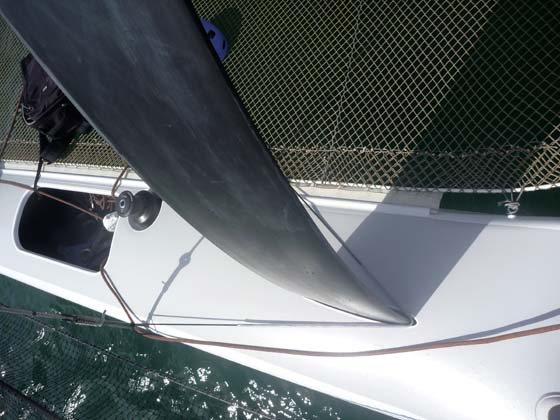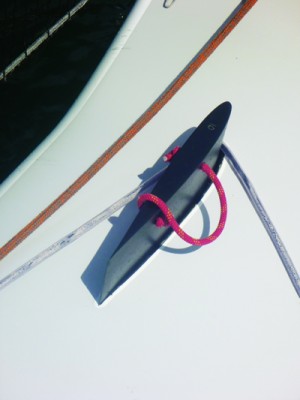When the World Match Racing Tour chose a high-speed cat as its next one-design racer, it seemed likely to fly out of reach of ordinary sailors.
But no, Matthew Sheahan finds her easy to sail
America’s Cup foiling cats look spectacular and turn plenty of heads, but the rate at which the demands of the new technology have been accelerating is leaving many of us trailing behind, unable to keep up with the skills required to master the new trend.
The Cup cats are not the only ones trailblazing a foiling future. Among the new breed of foiling machines, the A-Class cat, the Flying Phantom and Nacra F20 are examples of a new style of high-speed, high-octane, foilborne racing.
So when the World Match Racing Tour announced that it was switching from a range of conservative monohull keelboats, to a high-performance 32ft catamaran, some may have thought that even the cerebral sport of match racing would now be out of reach for anyone other than a talented cat sailor with no fear of heights.
These new cats were surely too big, too complex and, with the crew seated on the hiking wings and flying high enough above the water’s surface to bring on a bout of vertigo, this was surely just another example of the professional world scorching off into the distance.
But, as I discovered at first hand, you’d be wrong. The new M32 one-design cat is indeed quick, easily capable of 22 knots downwind. Even in the hands of an extra medium-sized, lunch-loving, dyed-in-the-wool monohull sailor, she was far easier than I had expected at hitting and sustaining high speeds while flying a hull downwind.
I was hooked
Within an hour aboard and 20 minutes on the helm I had settled down and was hooked. I had got used to flying above the water at heights you only normally experience on a flybridge motor cruiser as the cat heeled. I had got used to double figure speeds – although it didn’t stop me breaking into a grin each time – and I was now concentrating on trying to refine my technique to sail smoothly upwind in the gusty conditions, hitting the right numbers and keeping the windward hull flying.
A couple of hours later and the penny had fully dropped, leaving me wondering why I hadn’t noticed how radically different this boat is from when I had first seen her at the Düsseldorf boat show two years ago.
What I should have seen then was that this is a deceptively simple boat. For upwind work she has no jib, just a high aspect ratio, fully battened, soft, square-topped mainsail. She has no dolphin striker or stays, just a simple bowsprit for the furling Code 0, which is flown on the downwind legs.
She has a mainsheet running inside the boom to exit just abaft the gooseneck on the rotating aerofoil-section mast where it is then led out to the windward hull and trimmed by the forwardmost member of the four-strong crew. The mainsheet traveller is a curved affair with a simple line that comes from the centreline to control how far to leeward the car goes.
There are no complicated multi-purchase blocks and tackles either side – these can create unwanted friction to leeward as you try to haul the car up the track.
Other than the Code 0 sheet there are no ropes trailing across the trampoline. Even the curved daggerboards, which are designed to provide sufficient lift to keep the bows up – especially during a bear away or in a big gust at speed – are raised and lowered simply by pulling the handle on the top of the board, a technique that has worked fine in a Mirror dinghy for decades and works perfectly well here too.
Easily trailed
Designed by Göran Marström and Kåre Ljung, the M32 is a performance cat for enthusiastic amateur sailors that is also capable of being easily trailed. The fact that she weighs only 500kg all-up gives an indication of how light her component parts are and hence how easily she can be towed and rigged from the trailer by just two people in four hours with no specialist equipment. In addition, although she is 32ft LOA, she can be launched off the beach by hand just as you would with a dinghy cat.
The class is intended to be a strict one-design and has already set up and run a number of class regattas in North America and Scandinavia, with plans for an event in Bermuda. The intention is to develop this further for those who have the desire and the pockets to play on the international circuit. Given how easily the boat can be moved, this should prove to be good value.
But perhaps the most interesting new development for this boat and indeed the class, is that the World Match Racing Tour has adopted her in favour of the variety of monohulls that it currently uses/charters for its globe-trotting series.
It has been a long haul to convince the monohull sailing world that multis can be used for match racing. So when the America’s Cup made the leap and turned to multihulls, sailing’s ultimate match race broke a link with a long-established, successful and well regarded path to the world’s oldest international sporting trophy.
The World Match Racing Tour has frequently been the proving ground for match racing skippers and crew. Feeding into this, many national match racing circuits around the world provide one of the early stepping stones into this semi-professional world.
Re-establishing a link to the America’s Cup
When the Cup turned to cats, it was difficult to see how the WMT could continue to provide a pathway. This had a knock-on effect and threatened to polarise match racing. But now the link is re-established and, with the Olympic Nacra 17s proving popular, exciting and challenging for the next generation, it is easier to see where being a multihull expert might lead.
But simple and easy to handle though she is, the M32 is not going to start turning up in your local dinghy park. Her size and a price tag of US$245,000 ex VAT ex works (but including sails and cradle, etc) will see to that. But we will start to see better off teams and individuals buying their own boats either as training boats for the WMT or for the fleet racing regattas organised by the class association.
And if this potent cat isn’t enticing enough, perhaps the $1million prize money for the winner of the WMT will do the trick.
If a tubby, chicken-livered Technical Editor can get hooked on this boat in an hour, I suspect there could be a queue developing soon.
Curved daggerboards provide additional lift at speed, but the M32 does not foil. Boards are raised and lowered by hand, without control lines
The racks increase the total beam to 8.35m (27ft 5in), but are easy to get onto and surprisingly comfortable and secure when you’re there
The rotating aerofoil-section carbon mast has one set of spreaders with diamonds that are tensioned by a single nut under the mast
The simple single-line traveller system makes it easy to haul the mainsheet car up the track without friction from the leeward side
A simple, shallow crew cockpit makes it easy to brace yourself when using the non-self-tailing winch for the Code 0 sheet. There’s little else to put on it!
The daggerboards have simple rope handles to raise or lower them, keeping weight down
Specifications
LOA 9.68m/31ft 9in
Beam 5.54m/18ft 2in
incl racks/side wings 8.35m/27ft 5in
Sail area: Mainsail 52m2/560ft2
Gennaker 61m2/657ft2
Weight 510kg/1,124lb
Mast height 16.8m/55ft 1in
Designed by Göran Marström/Kåre Ljung
Built by Aston Harald Composite AB
Price US$214,000 (£138,590) ex sails, ex works, ex tax












